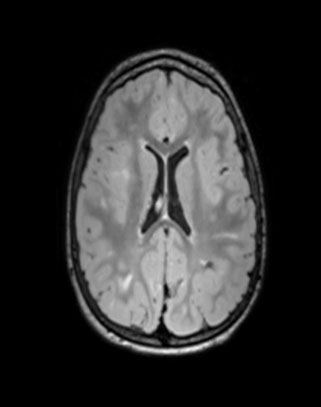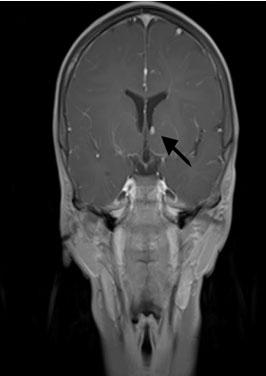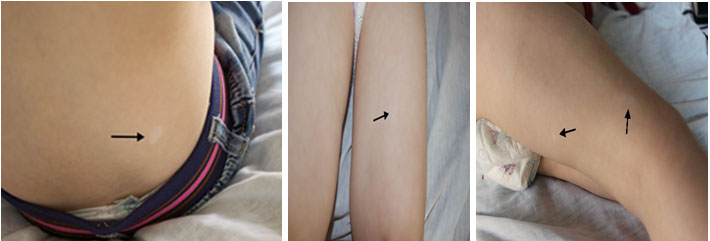 |
Case Report
Pharmaco-resistant epilepsy in tuberous sclerosis: A case report
1 MD Candidate, School of Medicine, University of Texas Medical Branch (UTMB), Galveston, Texas, United States of America
2 MD, Professor, Department of Pediatrics, University of Texas Medical Branch (UTMB), Galveston, Texas, United States of America
3 MD, Department of Pediatrics, Jordan Hospital, Amman, Jordan
4 MD, FAAP, Chairperson, Department of Pediatrics, Jordan Hospital, Amman, Jordan
5 MD, MPH, Director of Programs and Adjunct Assistant Professor, Center for Global and Community Health and Department of Pediatrics, University of Texas Medical Branch (UTMB), Galveston, Texas, United States of America
Address correspondence to:
Hani Serag
MD, MPH, The University of Texas Medical Branch (UTMB), 301 University Blvd., Galveston, Texas 77555-0920,
United States of America
Message to Corresponding Author
Article ID: 100091Z06SH2021
Access full text article on other devices
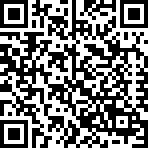
Access PDF of article on other devices
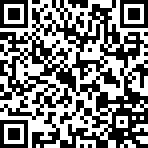
How to cite this article
Hussein S, Beach P, Khan M, Jabr M, Halazun J, Serag H. Pharmaco-resistant epilepsy in tuberous sclerosis: A case report. Case Rep Int 2021;10:100091Z06SH2021.ABSTRACT
A 3.5-year-old female from Palestine presented to Jordan Hospital with pharmaco-resistant epilepsy. She was diagnosed with tuberous sclerosis (TS) at six months of age. Onset of seizure activity, consisting of twitching and eye deviation, was noted at age one month. Her symptoms quickly progressed to infantile spasms. Various medications and dietary changes were implemented but without sustained seizure control. The patient underwent a vagal nerve stimulation procedure as a last resort to reduce seizure burden and frequency. Pharmaco-resistant epilepsy is defined as the failure of a patient′s seizures to respond to at least two antiepileptic medications that are appropriately chosen and used for an adequate period. Our protocol for vagal nerve stimulation for this age is to start with a stimulus level at 0.25 milliampere and increase it gradually until we reach 2.5 milliampere within six months. Vagal nerve stimulation proved to be a relatively effective method at reducing the frequency and severity of seizures in this case of pharmaco-resistant epilepsy due to TS. It is available to children even in some limited resource settings. Challenges remain for follow-up of in the setting of social unrest.
Keywords: Pediatrics, Pharmaco-resistant epilepsy, Tuberous sclerosis, Vagal nerve stimulation
INTRODUCTION
Tuberous sclerosis (TS) is a multisystem genetic disorder most frequently characterized by a triad of seizures, cognitive impairment, and cutaneous lesions (TS complex) [1]. Diagnostic criteria for tuberous sclerosis are shown in Table 1 and require two components of the major criteria or one component of the major criteria and two of the minor criteria (TS complex) [1]. Mutations in the TSC1 or TSC2 genes, which are believed to be involved in growth suppression, have also been linked to this condition [2]. Tuberous sclerosis is associated with cardiac rhabdomyoma, commonly noted in pre- or postnatal ultrasound [2]. Families should be counseled on the likelihood of experiencing early onset seizures in the presence of cardiac rhabdomyoma, pending completion of clinical and laboratory/diagnostic confirmation of findings [3].
Epilepsy is a common manifestation of TS and occurs in 80–90% of those affected infants [4]. The onset of seizures typically occurs within the first year of life and up to 1/3 of children will develop infantile spasms [4]. Cortical tubers, common benign hamartomatous lesions found in the brain of these patients, are hypothesized to create epileptogenic foci and to contribute to thepharmaco-resistant nature of epilepsy [5]. Early onset of seizures is associated with resistance to treatment and cognitive impairment [6]. In the US ACTH is the mainstay of treatment for infantile spasms, but Vigabatrin is widely used in other settings [2]. Non-pharmocologic interventions include a ketogenic diet, vagal nerve stimulation, and epilepsy surgery [2].
In this article, we report a case of a 3.5-year-old female from Palestine presenting to Jordan Hospital with pharmaco-resistant epilepsy and TS.
CASE REPORT
A 3.5-year-old female presented to Jordan Hospital in Amman seeking treatment for pharmaco-resistant epilepsy. At one month of age she developed twitching and deviation of the right eye which progressed to typical infantile spasms over the next several months. At two months she was admitted to Makassed Charitable Hospital in Jerusalem for further workup of a systolic heart murmur. An echocardiogram (EEG) revealed the presence of a cardiac rhabdomyoma. At the age of four months she experienced bouts of described as startle-like activity over 24 hours occurring more frequently than once an hour. A 24-hour EEG showed abnormal background spikes and polyspikes with slow wave activity, typical of hypsarrhythmia, and she was diagnosed with West Syndrome infantile spasms. Therapy was initiated with Vigabatrin, followed quickly with added valproate and hydrocortisone. Seizure frequency was reportedly reduced by 20% for the next five months.
At five months a brain magnetic resonance imaging (MRI) showed the presence of cortical tubers in the left frontal area with subependymal nodules. A renal ultrasound showed an 8×8 mm cyst on the right upper pole of the kidney and 7×5 mm cyst on the left kidney, and the suspected TS was diagnosed. At 11 months of age, the patient’s seizures intensified. She was seen in Caritas Baby Hospital in Bethlehem, and medications were changed to Levetiracetam, Clozabam, and Carbamazepine. A request was submitted a month later at Al-Makassed Hospital but could not be obtained. Due to poor seizure control a ketogenic diet was initiated, but discontinued by the family in one week for “intolerable side effects.” At 13 months of age she was referred to al Hadassa in Israel for consideration of surgical intervention. An EEG again showed generalized and multifocal spikes. Magnetic resonance imaging was unchanged.
For the next two years the patient remained on Valproic acid, Lamotrigine, and Clobazam, but seizures were refractory to treatment. Consideration of a vagal nerve stimulator (VNS) or epilepsy surgery was recommended, and evaluation at Jordan Hospital was approved by the Palestinian government. Upon admission to Jordan Hospital, the patient underwent imaging studies, which confirmed the presence of calcifications consistent with cortical dysplasia (Figure 1), subependymal nodules (Figure 2), and renal cysts (Figure 3). Physical exam revealed multiple hypo-melanotic macules (Figure 4), all consistent with a diagnosis of TS. Developmental evaluation showed inability to ambulate independently until three years of age and current unsteady gait. Language was delayed for age, using only short phrases, inability to ride a tricycle, or draw a circle. She is not toilet trained. Her behavior shows disinhibited social engagement with overt friendly behaviors toward strangers. A VNS was placed at Jordan Hospital. The patient successfully underwent a vagal nerve stimulation procedure with successful parent training for use. Our protocol for vagal nerve stimulation for this age is to start with a stimulus level at 0.25 milliampere and increase it gradually by 10% at a time to reach 2.5 milliampere. The child tolerated 2.5 milliampere which we did not exceed. Five months post-procedure, she had a 50% decrease in both seizure frequency and severity, which was assessed and measured using a seizure log given to the patient’s parents. Effectiveness of the VNS device will continue to be monitored and assessed, as maximum effect is best seen after one year of usage.
DISCUSSION
Pharmaco-resistant epilepsy is commonly found in patients with TS and multiple theories have attributed the epileptogenic activity with the presence of tuberous lesions in the brain [5]. Studies have shown that in patients with TS who present with epileptic activity before any other clinical signs or symptoms of the disorder, the subsequent risk of further seizure development is 100% [6]. Although Vigabatrin has been shown to effectively treat infants with infantile spasms the patient discussed in our case did not benefit [2]. Vigabatrin therapy is concerning to some experts due to potential adverse effects on vision and neurotoxicity [7]. Adrenocorticotropic hormone (ACTH) has remained the mainstay of therapy in other settings for many years, but with variable efficacy [8]. Multiple second line therapies including diet alterations were also not effective in controlling seizure frequency and severity [8].
This patient’s clinical journey at diagnosis and treatment was complicated by many socio-economic and geo-political factors. The patient and her family reside in Palestine and have been able to receive the majority of their care in Israeli hospital systems. In 2019, however, Palestinian authorities began to stop sending their citizens to Israeli hospitals due to rising political tensions between the two governments. Instead, qualified patients were sent to neighboring countries such as Jordan, Lebanon, and Egypt. Jordan Hospital in Amman is a tertiary hospital and protocols are in place that facilitates the treatment of Palestinian citizens. Physicians at hospitals such as Makassed and Hadassa send a detailed report to Jordan Hospital regarding a patient, and the physicians at Jordan Hospital are then allowed to accept the case for further management. They are 100% insured at Jordan Hospital and procedures like the VNS are around 70% covered through insurance. In our patient’s hospitalization was completely covered by the Palestinian authorities, but her procedure required a copayment of about 2000 JD (Jordanian dinar). In addition, a two-week post-hospital stay in Amman was necessary for calibration of the device with cost of outpatient stay not covered by the Palestinian authorities.
CONCLUSION
This case presentation demonstrates the significance of pharmaco-resistant epilepsy and the success of vagal nerve stimulation procedures in reducing seizure burden even in low resource settings. Management of complex problems such as TS is challenging in any setting, and with the added complexity of evolving socio-political issues there are additional barriers to care. Early identification of the clinical signs of TS is essential to comprehensive care, improves quality of life for the child and family, and may improve developmental progress.
REFERENCE
1.
Portocarrero LKL, Quental KN, Samorano LP, de Oliveira ZNP, Rivitti-Machado MCM. Tuberous sclerosis complex: Review based on new diagnostic criteria. An Bras Dermatol 2018;93(3):323–31. [CrossRef]
[Pubmed]

2.
Thiele EA. Managing and understanding epilepsy in tuberous sclerosis complex. Epilepsia 2010;51 Suppl 1:90–1. [CrossRef]
[Pubmed]

3.
Hinton RB, Prakash A, Romp RL, Krueger DA, Knilans TK. Cardiovascular manifestations of tuberous sclerosis complex and summary of the revised diagnostic criteria and surveillance and management recommendations from the International Tuberous Sclerosis Consensus Group. J Am Heart Assoc 2014;3(6):001493. [CrossRef]
[Pubmed]

4.
Wang S, Fallah A. Optimal management of seizures associated with tuberous sclerosis complex: Current and emerging options. Neuropsychiatr Dis Treat 2014;10:2021–30. [CrossRef]
[Pubmed]

5.
Lazarowski A, Lubieniecki F, Camarero S, et al. Multidrug resistance proteins in tuberous sclerosis and refractory epilepsy. Pediatr Neurol 2004;30(2):102–6. [CrossRef]
[Pubmed]

6.
Curatolo P, Moavero R, de Vries PJ. Neurological and neuropsychiatric aspects of tuberous sclerosis complex. Lancet Neurol 2015;14(7):733–45. [CrossRef]
[Pubmed]

7.
Curatolo P, Verdecchia M, Bombardieri R. Vigabatrin for tuberous sclerosis complex. Brain Dev 2001;23(7):649–53. [CrossRef]
[Pubmed]

8.
Nelson GR. Management of infantile spasms. Transl Pediatr 2015;4(4):260–70. [CrossRef]
[Pubmed]

9.
Kwan P, Arzimanoglou A, Berg AT, et al. Definition of drug resistant epilepsy: Consensus proposal by the ad hoc Task Force of the ILAE Commission on Therapeutic Strategies. Epilepsia 2010;51(6):1069–77. [CrossRef]
[Pubmed]

SUPPORTING INFORMATION
Acknowledgement
We would like to acknowledge and thank Dr. Abdalla Bashir, MD, FRCSEd, FACS, the chairman of the board of directors of the Jordan Hospital in Amman, Jordan, for his outstanding support to along all stages of this work.
Author ContributionsSarah Hussein - Conception of the work, Design of the work, Acquisition of data, Analysis of data, Drafting the work, Revising the work critically for important intellectual content, Final approval of the version to be published, Agree to be accountable for all aspects of the work in ensuring that questions related to the accuracy or integrity of any part of the work are appropriately investigated and resolved.
Patricia Beach - Conception of the work, Design of the work, Acquisition of data, Analysis of data, Drafting the work, Revising the work critically for important intellectual content, Final approval of the version to be published, Agree to be accountable for all aspects of the work in ensuring that questions related to the accuracy or integrity of any part of the work are appropriately investigated and resolved.
Maryam Khan - Conception of the work, Design of the work, Acquisition of data, Analysis of data, Drafting the work, Revising the work critically for important intellectual content, Final approval of the version to be published, Agree to be accountable for all aspects of the work in ensuring that questions related to the accuracy or integrity of any part of the work are appropriately investigated and resolved.
Mariam Jabr - Conception of the work, Design of the work, Acquisition of data, Analysis of data, Drafting the work, Revising the work critically for important intellectual content, Final approval of the version to be published, Agree to be accountable for all aspects of the work in ensuring that questions related to the accuracy or integrity of any part of the work are appropriately investigated and resolved.
Jarir Halazun - Conception of the work, Design of the work, Acquisition of data, Analysis of data, Drafting the work, Revising the work critically for important intellectual content, Final approval of the version to be published, Agree to be accountable for all aspects of the work in ensuring that questions related to the accuracy or integrity of any part of the work are appropriately investigated and resolved.
Hani Serag - Conception of the work, Design of the work, Acquisition of data, Analysis of data, Drafting the work, Revising the work critically for important intellectual content, Final approval of the version to be published, Agree to be accountable for all aspects of the work in ensuring that questions related to the accuracy or integrity of any part of the work are appropriately investigated and resolved.
Guarantor of SubmissionThe corresponding author is the guarantor of submission.
Source of SupportNone
Consent StatementWritten informed consent was obtained from the patient for publication of this article.
Data AvailabilityAll relevant data are within the paper and its Supporting Information files.
Conflict of InterestAuthors declare no conflict of interest.
Copyright© 2021 Sarah Hussein et al. This article is distributed under the terms of Creative Commons Attribution License which permits unrestricted use, distribution and reproduction in any medium provided the original author(s) and original publisher are properly credited. Please see the copyright policy on the journal website for more information.


